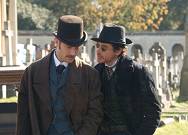|
|
||||
|
|
by John P. McCarthy  Sherlock Holmes is pleasantly paradoxical. On the one hand, it plays not so differently than a 1930s feature starring Basil Rathbone as the famous sleuth -- watched on a rainy Saturday afternoon in front of the TV. On the other, it offers the pleasures of a modern, frenetic, and effects-laden blockbuster. With Robert Downey Jr. headlining as an equally brainy and physical Holmes, director Guy Ritchie has made an up-to-date movie without letting anything newfangled overwhelm Arthur Conan Doyle's beloved characters or the yarn -- which, it must be said, has as much in common with Dan Brown's latest potboiler The Lost Symbol than, say, The Hound of the Baskervilles. Satisfying the expectations of contemporary moviegoers while not dissing the source material or being overly serious is far from an elementary achievement. In light of Ritchie's best films -- Lock, Stock & Two Smoking Barrels and Snatch -- it figures he would gravitate toward the London-set exploits of a detective unafraid of immersing himself in that city's criminal underworld. And while he's following in the footsteps of accomplished helmers such as Billy Wilder, Barry Levinson, Herbert Ross, and, not forgetting the comedic angle, Gene Wilder, his leading man has numerous impressive forbearers. In addition to Rathbone's prototypical Holmes, there's Jeremy Brett's effetely high-strung detective and Nicol Williamson's cocaine-addicted Sherlock. Expectations are always high for a performance by the talented Downey, particularly after he revitalized the action-fantasy superhero in Iron Man. Aside from his shaky British accent, which results in a few garbled lines, no unusual powers are needed to deduce he's done the same for this role. His Holmes combines the qualities of a highly cerebral and neurotic sleuth like Monk with the derring-do and masochistic physicality of an urban brawler in Fight Club. He's unkempt -- slovenly even -- but despite an apparent lack of hygiene (grungy flair, if you're being charitable) his mind and body are decidedly fit. He's a physical and mental specimen to be reckoned with -- a skilled pugilist who engages in bare-knuckle boxing matches when bored. Besides this physical stimulation, he craves "data" on which to train his gray matter. Facts are his lifeblood, though it's a wonder his brain can process anything after enduring (and administering) so many blows. His hunger for pertinent information and extreme fisticuffs does leave ample time for lighthearted banter; and, rest assured, Downey's Sherlock still smokes a pipe and likes to pluck on his violin when noodling a problem or killing time before his next thought-provoking case. Perhaps his most peculiar feature is his relationship with Dr. Watson, played with proper second-banana understatement and no hint of fustiness by Jude Law. With Watson engaged to be married and in the process of moving out of 221B Baker Street, Holmes is forlorn and jealous. There's a strong, half-joking suggestion they've been more than friends and colleagues, and their emotional bond leads to some petulant squabbling and sharp ribbing. While Watson has a gambling addiction, it seems Holmes -- whose fondness for cocaine is mentioned in passing -- is addicted to Watson and isn't taking his departure in stride. In a pre-title sequence, the crime-solving duo saves a maiden from being sacrificed during an occult ritual by Lord Blackwood (Mark Strong). This twisted peer of the realm summons Holmes to his cell before he's to be hanged and warns of impending murders and chaos. Sure enough, after Watson pronounces Blackwood dead, he rises from his grave and terrorizes London with acts of black magic. Sherlock's old flame Irene Adler (Rachel McAdams) turns up, having been hired by a mysterious figure to work the case. She and Holmes tangle but soon join forces to foil Blackwood's plot to blow up Parliament and seize control of the British Empire along with a fraternity of quasi-Masonic cohorts. This involves a number of slickly entertaining action set pieces that take place at a Thames shipyard, in a slaughterhouse, in the sewers beneath Westminster, and high above the river on the Tower Bridge. Ritchie and his crew stage, shoot and edit these scenes with admirable energy and also devise a nifty way of depicting Holmes' sleuthing processes that uses slow motion to admirable effect. Keeping the logic straight and the tone light is a challenge that is well met. The movie's flashes of modern irony mesh well with its charms as an old-fashioned detective serial. Sherlock Holmes aficionados will be gratified to learn that the villainous Professor Moriarty makes an appearance and helps set up the sequel. Additional spiffy adventures of Sherlock Holmes are in the offing. Maybe even a new version of The Hound of the Baskervilles. (Released by Warner Bros. Pictures and rated "PG-13" for intense sequences of violence and action, some startling images and a scene of suggestive material.) |
||
|
© 2025 - ReelTalk Movie Reviews Website designed by Dot Pitch Studios, LLC |



